Detailed Analysis of Cut and Fill Estimation in Civil Engineering
VerifiedAdded on 2023/06/03
|7
|1046
|491
Homework Assignment
AI Summary
This assignment focuses on cut and fill estimation, a critical aspect of civil engineering, particularly in construction projects. The solution demonstrates the application of the 4-corner or grid method to calculate cut and fill volumes. The assignment outlines assumptions, such as the removal of topsoil, and provides detailed calculations for four grids. It calculates elevation differences, average depths, and volumes for both cut and fill operations. The calculations include area, average height, and volume of cut and fill for each grid, along with a summary table presenting the final cut and fill volumes. The document also includes references to relevant literature on earthwork volume estimation methods.
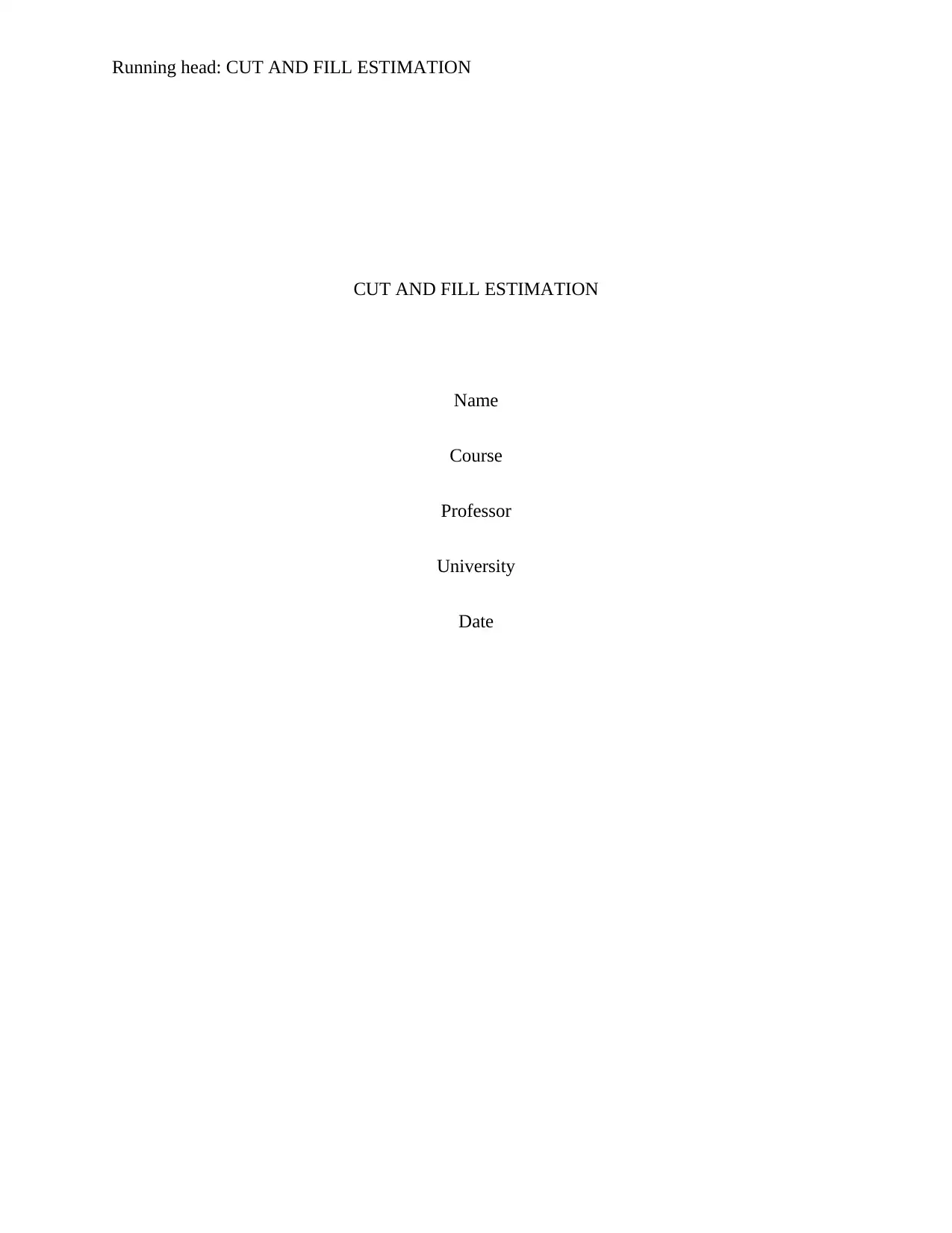
Running head: CUT AND FILL ESTIMATION
CUT AND FILL ESTIMATION
Name
Course
Professor
University
Date
CUT AND FILL ESTIMATION
Name
Course
Professor
University
Date
Paraphrase This Document
Need a fresh take? Get an instant paraphrase of this document with our AI Paraphraser
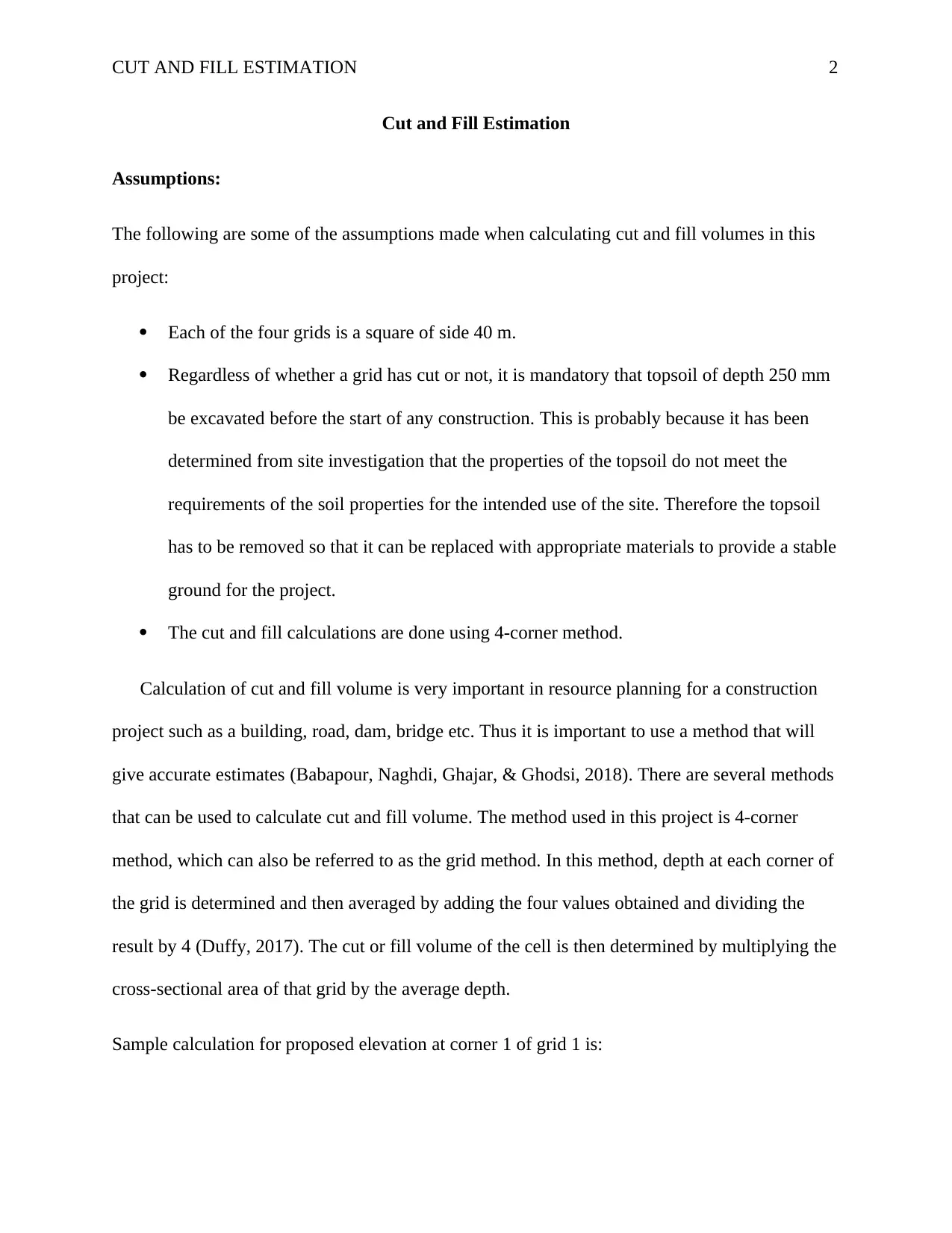
CUT AND FILL ESTIMATION 2
Cut and Fill Estimation
Assumptions:
The following are some of the assumptions made when calculating cut and fill volumes in this
project:
Each of the four grids is a square of side 40 m.
Regardless of whether a grid has cut or not, it is mandatory that topsoil of depth 250 mm
be excavated before the start of any construction. This is probably because it has been
determined from site investigation that the properties of the topsoil do not meet the
requirements of the soil properties for the intended use of the site. Therefore the topsoil
has to be removed so that it can be replaced with appropriate materials to provide a stable
ground for the project.
The cut and fill calculations are done using 4-corner method.
Calculation of cut and fill volume is very important in resource planning for a construction
project such as a building, road, dam, bridge etc. Thus it is important to use a method that will
give accurate estimates (Babapour, Naghdi, Ghajar, & Ghodsi, 2018). There are several methods
that can be used to calculate cut and fill volume. The method used in this project is 4-corner
method, which can also be referred to as the grid method. In this method, depth at each corner of
the grid is determined and then averaged by adding the four values obtained and dividing the
result by 4 (Duffy, 2017). The cut or fill volume of the cell is then determined by multiplying the
cross-sectional area of that grid by the average depth.
Sample calculation for proposed elevation at corner 1 of grid 1 is:
Cut and Fill Estimation
Assumptions:
The following are some of the assumptions made when calculating cut and fill volumes in this
project:
Each of the four grids is a square of side 40 m.
Regardless of whether a grid has cut or not, it is mandatory that topsoil of depth 250 mm
be excavated before the start of any construction. This is probably because it has been
determined from site investigation that the properties of the topsoil do not meet the
requirements of the soil properties for the intended use of the site. Therefore the topsoil
has to be removed so that it can be replaced with appropriate materials to provide a stable
ground for the project.
The cut and fill calculations are done using 4-corner method.
Calculation of cut and fill volume is very important in resource planning for a construction
project such as a building, road, dam, bridge etc. Thus it is important to use a method that will
give accurate estimates (Babapour, Naghdi, Ghajar, & Ghodsi, 2018). There are several methods
that can be used to calculate cut and fill volume. The method used in this project is 4-corner
method, which can also be referred to as the grid method. In this method, depth at each corner of
the grid is determined and then averaged by adding the four values obtained and dividing the
result by 4 (Duffy, 2017). The cut or fill volume of the cell is then determined by multiplying the
cross-sectional area of that grid by the average depth.
Sample calculation for proposed elevation at corner 1 of grid 1 is:
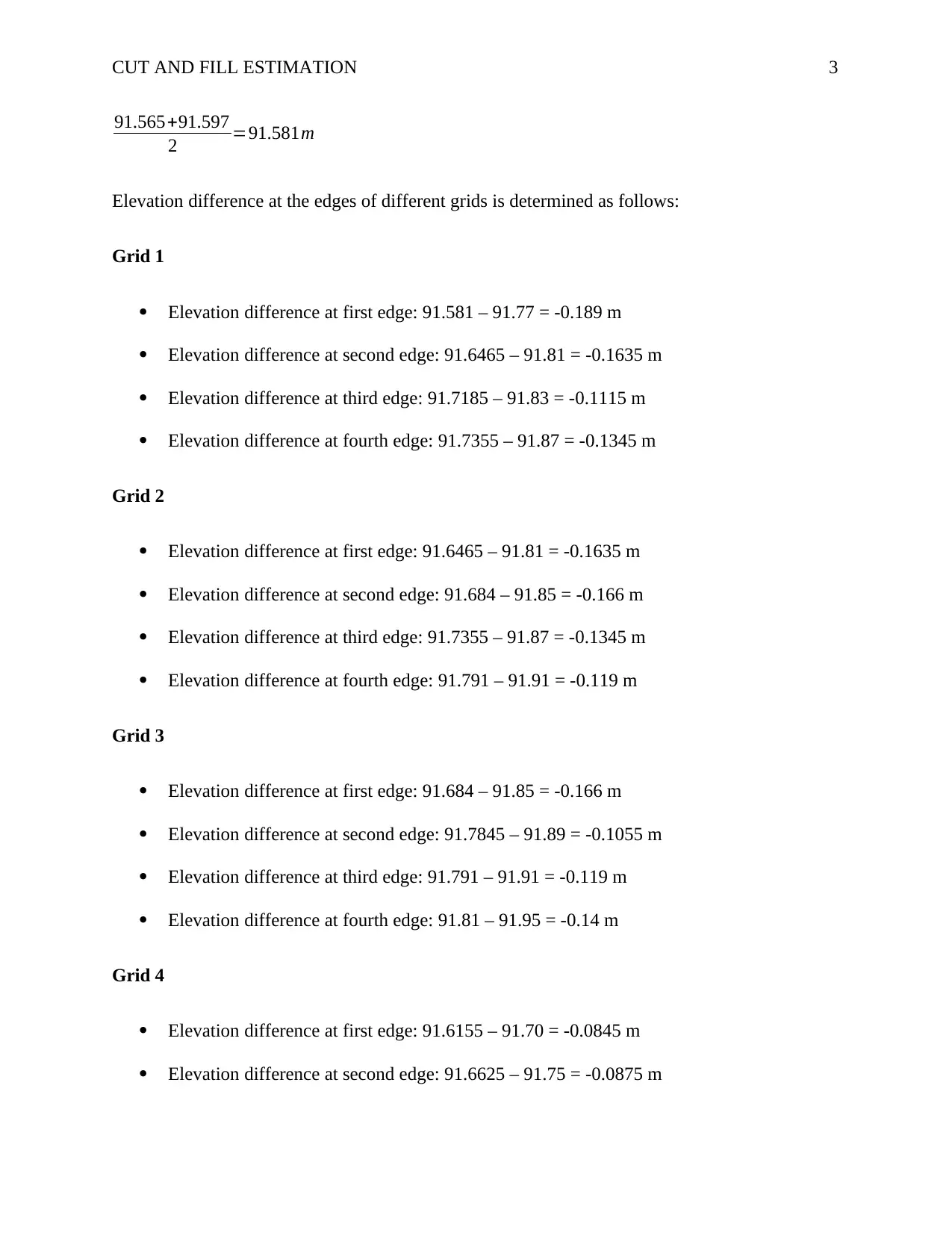
CUT AND FILL ESTIMATION 3
91.565+91.597
2 =91.581m
Elevation difference at the edges of different grids is determined as follows:
Grid 1
Elevation difference at first edge: 91.581 – 91.77 = -0.189 m
Elevation difference at second edge: 91.6465 – 91.81 = -0.1635 m
Elevation difference at third edge: 91.7185 – 91.83 = -0.1115 m
Elevation difference at fourth edge: 91.7355 – 91.87 = -0.1345 m
Grid 2
Elevation difference at first edge: 91.6465 – 91.81 = -0.1635 m
Elevation difference at second edge: 91.684 – 91.85 = -0.166 m
Elevation difference at third edge: 91.7355 – 91.87 = -0.1345 m
Elevation difference at fourth edge: 91.791 – 91.91 = -0.119 m
Grid 3
Elevation difference at first edge: 91.684 – 91.85 = -0.166 m
Elevation difference at second edge: 91.7845 – 91.89 = -0.1055 m
Elevation difference at third edge: 91.791 – 91.91 = -0.119 m
Elevation difference at fourth edge: 91.81 – 91.95 = -0.14 m
Grid 4
Elevation difference at first edge: 91.6155 – 91.70 = -0.0845 m
Elevation difference at second edge: 91.6625 – 91.75 = -0.0875 m
91.565+91.597
2 =91.581m
Elevation difference at the edges of different grids is determined as follows:
Grid 1
Elevation difference at first edge: 91.581 – 91.77 = -0.189 m
Elevation difference at second edge: 91.6465 – 91.81 = -0.1635 m
Elevation difference at third edge: 91.7185 – 91.83 = -0.1115 m
Elevation difference at fourth edge: 91.7355 – 91.87 = -0.1345 m
Grid 2
Elevation difference at first edge: 91.6465 – 91.81 = -0.1635 m
Elevation difference at second edge: 91.684 – 91.85 = -0.166 m
Elevation difference at third edge: 91.7355 – 91.87 = -0.1345 m
Elevation difference at fourth edge: 91.791 – 91.91 = -0.119 m
Grid 3
Elevation difference at first edge: 91.684 – 91.85 = -0.166 m
Elevation difference at second edge: 91.7845 – 91.89 = -0.1055 m
Elevation difference at third edge: 91.791 – 91.91 = -0.119 m
Elevation difference at fourth edge: 91.81 – 91.95 = -0.14 m
Grid 4
Elevation difference at first edge: 91.6155 – 91.70 = -0.0845 m
Elevation difference at second edge: 91.6625 – 91.75 = -0.0875 m
⊘ This is a preview!⊘
Do you want full access?
Subscribe today to unlock all pages.

Trusted by 1+ million students worldwide
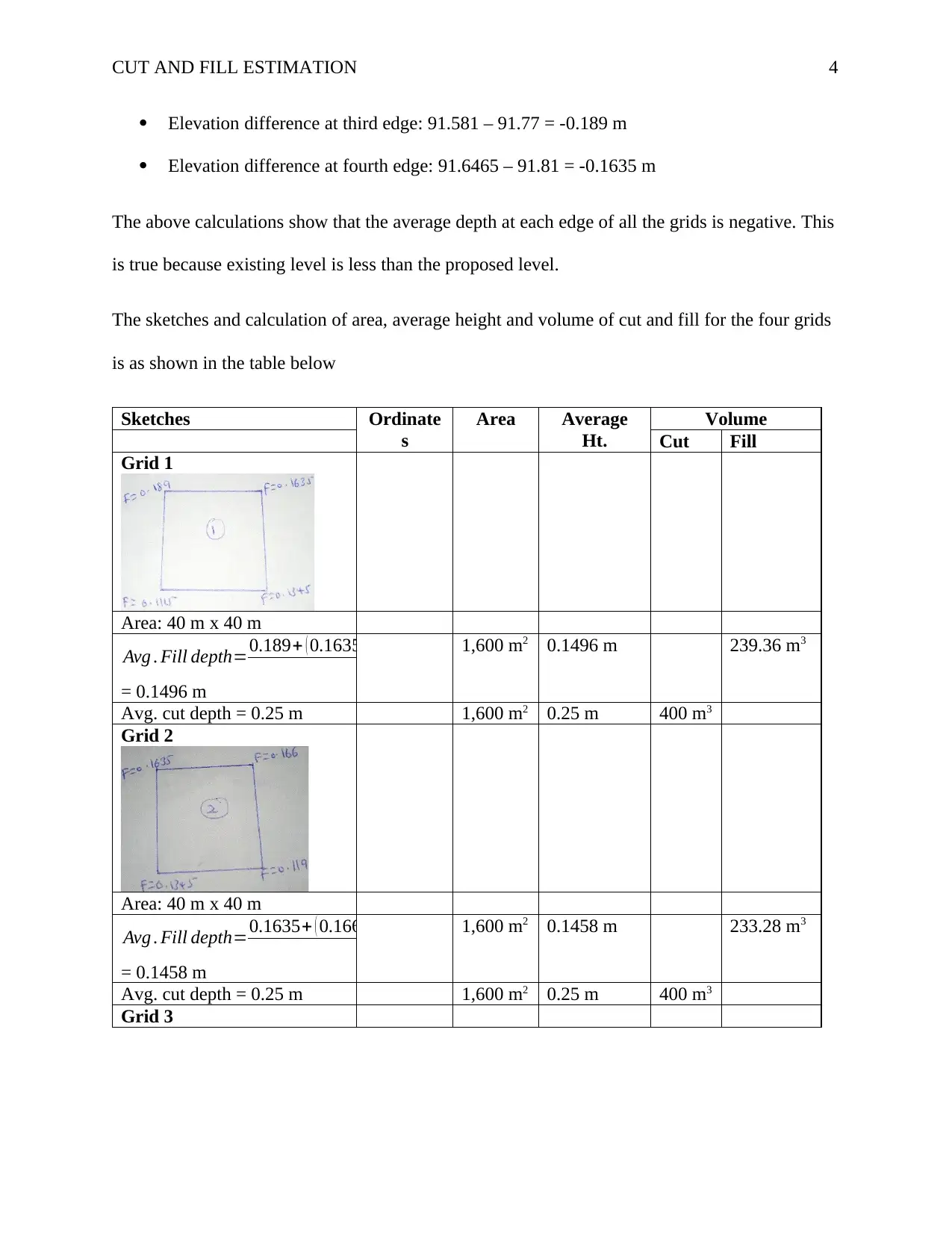
CUT AND FILL ESTIMATION 4
Elevation difference at third edge: 91.581 – 91.77 = -0.189 m
Elevation difference at fourth edge: 91.6465 – 91.81 = -0.1635 m
The above calculations show that the average depth at each edge of all the grids is negative. This
is true because existing level is less than the proposed level.
The sketches and calculation of area, average height and volume of cut and fill for the four grids
is as shown in the table below
Sketches Ordinate
s
Area Average
Ht.
Volume
Cut Fill
Grid 1
Area: 40 m x 40 m
Avg . Fill depth=0.189+ ( 0.1635 ) + ( 0.1115 ) + ( 0.1345 )
4
= 0.1496 m
1,600 m2 0.1496 m 239.36 m3
Avg. cut depth = 0.25 m 1,600 m2 0.25 m 400 m3
Grid 2
Area: 40 m x 40 m
Avg . Fill depth=0.1635+ ( 0.166 ) + ( 0.1345 ) + ( 0.119 )
4
= 0.1458 m
1,600 m2 0.1458 m 233.28 m3
Avg. cut depth = 0.25 m 1,600 m2 0.25 m 400 m3
Grid 3
Elevation difference at third edge: 91.581 – 91.77 = -0.189 m
Elevation difference at fourth edge: 91.6465 – 91.81 = -0.1635 m
The above calculations show that the average depth at each edge of all the grids is negative. This
is true because existing level is less than the proposed level.
The sketches and calculation of area, average height and volume of cut and fill for the four grids
is as shown in the table below
Sketches Ordinate
s
Area Average
Ht.
Volume
Cut Fill
Grid 1
Area: 40 m x 40 m
Avg . Fill depth=0.189+ ( 0.1635 ) + ( 0.1115 ) + ( 0.1345 )
4
= 0.1496 m
1,600 m2 0.1496 m 239.36 m3
Avg. cut depth = 0.25 m 1,600 m2 0.25 m 400 m3
Grid 2
Area: 40 m x 40 m
Avg . Fill depth=0.1635+ ( 0.166 ) + ( 0.1345 ) + ( 0.119 )
4
= 0.1458 m
1,600 m2 0.1458 m 233.28 m3
Avg. cut depth = 0.25 m 1,600 m2 0.25 m 400 m3
Grid 3
Paraphrase This Document
Need a fresh take? Get an instant paraphrase of this document with our AI Paraphraser
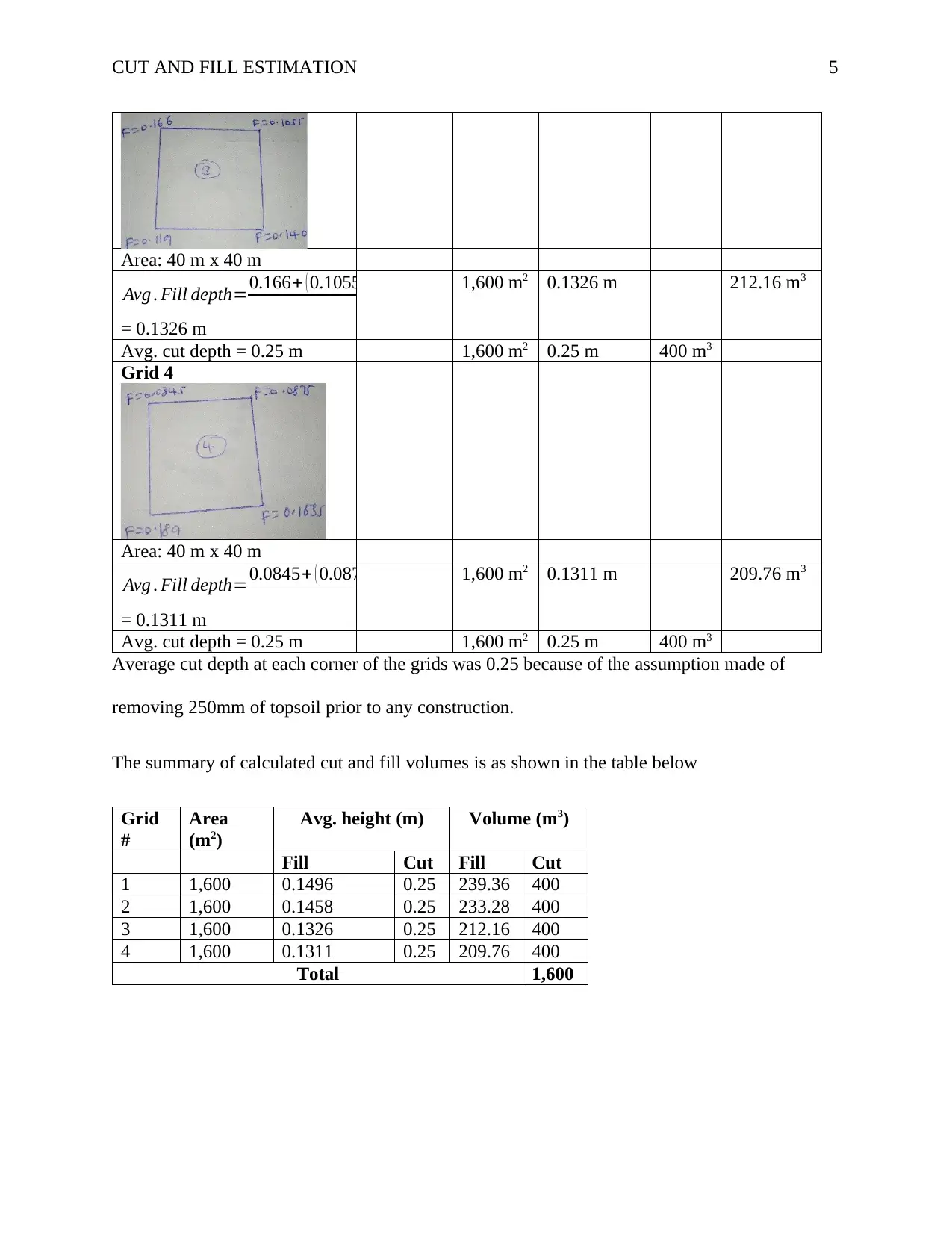
CUT AND FILL ESTIMATION 5
Area: 40 m x 40 m
Avg . Fill depth=0.166+ ( 0.1055 ) + ( 0.119 ) + ( 0.14 )
4
= 0.1326 m
1,600 m2 0.1326 m 212.16 m3
Avg. cut depth = 0.25 m 1,600 m2 0.25 m 400 m3
Grid 4
Area: 40 m x 40 m
Avg . Fill depth=0.0845+ ( 0.0875 ) + ( 0.189 ) + ( 0.1635 )
4
= 0.1311 m
1,600 m2 0.1311 m 209.76 m3
Avg. cut depth = 0.25 m 1,600 m2 0.25 m 400 m3
Average cut depth at each corner of the grids was 0.25 because of the assumption made of
removing 250mm of topsoil prior to any construction.
The summary of calculated cut and fill volumes is as shown in the table below
Grid
#
Area
(m2)
Avg. height (m) Volume (m3)
Fill Cut Fill Cut
1 1,600 0.1496 0.25 239.36 400
2 1,600 0.1458 0.25 233.28 400
3 1,600 0.1326 0.25 212.16 400
4 1,600 0.1311 0.25 209.76 400
Total 1,600
Area: 40 m x 40 m
Avg . Fill depth=0.166+ ( 0.1055 ) + ( 0.119 ) + ( 0.14 )
4
= 0.1326 m
1,600 m2 0.1326 m 212.16 m3
Avg. cut depth = 0.25 m 1,600 m2 0.25 m 400 m3
Grid 4
Area: 40 m x 40 m
Avg . Fill depth=0.0845+ ( 0.0875 ) + ( 0.189 ) + ( 0.1635 )
4
= 0.1311 m
1,600 m2 0.1311 m 209.76 m3
Avg. cut depth = 0.25 m 1,600 m2 0.25 m 400 m3
Average cut depth at each corner of the grids was 0.25 because of the assumption made of
removing 250mm of topsoil prior to any construction.
The summary of calculated cut and fill volumes is as shown in the table below
Grid
#
Area
(m2)
Avg. height (m) Volume (m3)
Fill Cut Fill Cut
1 1,600 0.1496 0.25 239.36 400
2 1,600 0.1458 0.25 233.28 400
3 1,600 0.1326 0.25 212.16 400
4 1,600 0.1311 0.25 209.76 400
Total 1,600
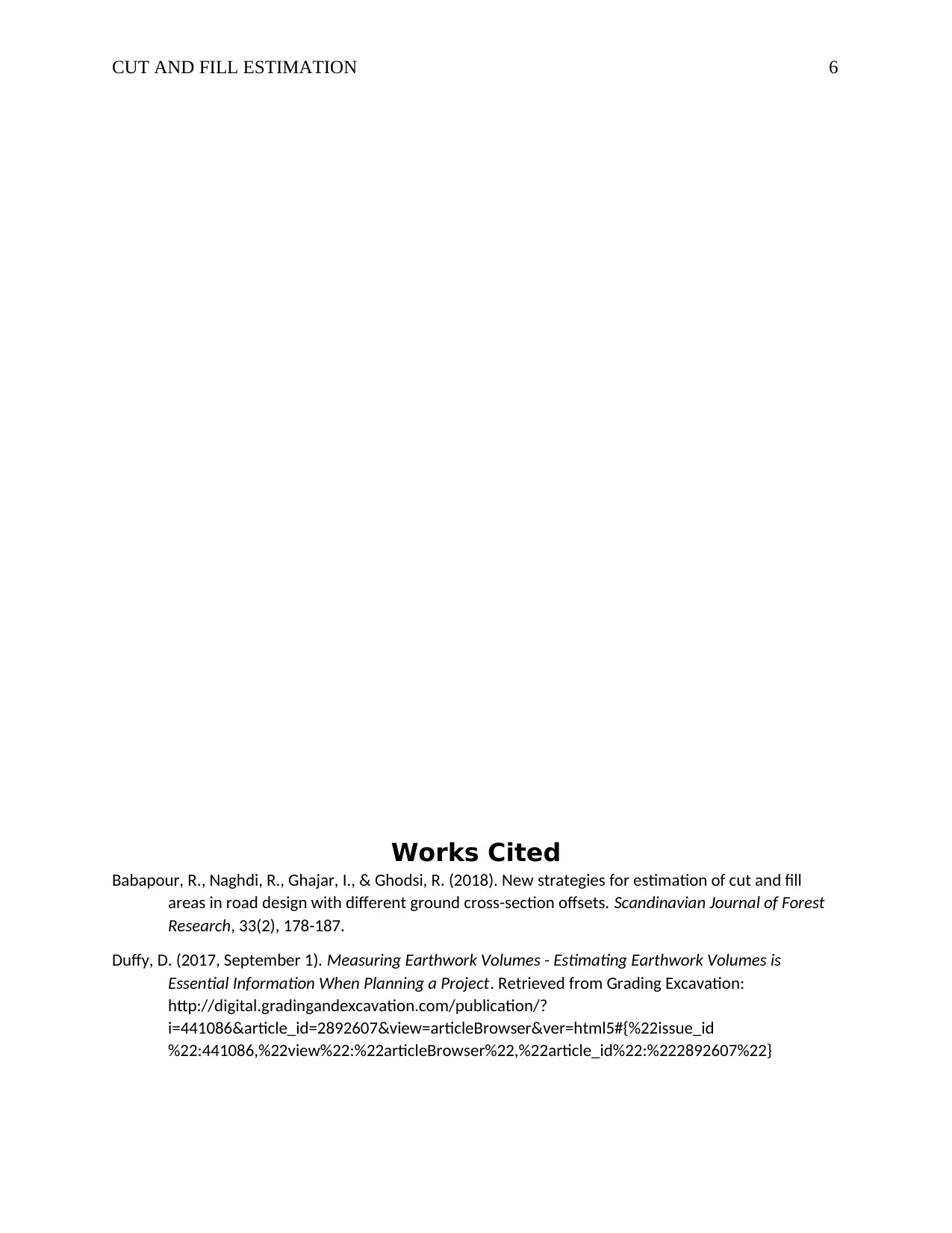
CUT AND FILL ESTIMATION 6
Works Cited
Babapour, R., Naghdi, R., Ghajar, I., & Ghodsi, R. (2018). New strategies for estimation of cut and fill
areas in road design with different ground cross-section offsets. Scandinavian Journal of Forest
Research, 33(2), 178-187.
Duffy, D. (2017, September 1). Measuring Earthwork Volumes - Estimating Earthwork Volumes is
Essential Information When Planning a Project. Retrieved from Grading Excavation:
http://digital.gradingandexcavation.com/publication/?
i=441086&article_id=2892607&view=articleBrowser&ver=html5#{%22issue_id
%22:441086,%22view%22:%22articleBrowser%22,%22article_id%22:%222892607%22}
Works Cited
Babapour, R., Naghdi, R., Ghajar, I., & Ghodsi, R. (2018). New strategies for estimation of cut and fill
areas in road design with different ground cross-section offsets. Scandinavian Journal of Forest
Research, 33(2), 178-187.
Duffy, D. (2017, September 1). Measuring Earthwork Volumes - Estimating Earthwork Volumes is
Essential Information When Planning a Project. Retrieved from Grading Excavation:
http://digital.gradingandexcavation.com/publication/?
i=441086&article_id=2892607&view=articleBrowser&ver=html5#{%22issue_id
%22:441086,%22view%22:%22articleBrowser%22,%22article_id%22:%222892607%22}
⊘ This is a preview!⊘
Do you want full access?
Subscribe today to unlock all pages.

Trusted by 1+ million students worldwide

CUT AND FILL ESTIMATION 7
1 out of 7
Related Documents
Your All-in-One AI-Powered Toolkit for Academic Success.
+13062052269
info@desklib.com
Available 24*7 on WhatsApp / Email
![[object Object]](/_next/static/media/star-bottom.7253800d.svg)
Unlock your academic potential
Copyright © 2020–2025 A2Z Services. All Rights Reserved. Developed and managed by ZUCOL.



